2009 Okie-Tex Star Party
My f/3
scope stays home. I bring a 14.5" f/2.55. Rick
Singmaster brings a 22" f/3.3.
The Paracorr 2 is tested.
Fun is had by all, including Al Nagler.
All images and text Copyright Mike Lockwood, 2009
After a very successful Winter Star Party where I showed countless attendees views of Saturn, the moon, and deep-sky objects through my one-of-a-kind 20" F/3 MX Starmaster telescope, I decided that I needed to try to place a lower bound on the practical speed of visual Newtonian telescopes.
With the great success at F/3, I looked at a fairly compact instrument of smaller aperture to serve as a test bed for various eyepieces and correctors. John Pratte had a spare 14.5" blank, 1.38" thick, so that decision was easy. (It's a little bit ironic that this mirror is thicker than the 20" F/3 mirror!)
Wanting to keep central obstruction below 35% and preferably closer to 30%, I hit upon a focal ratio of about F/2.5-2.6. This meant a 4.5" m.a. flat was necessary to illuminate the center of the field, with a 31% obstruction, and this is exactly what I used (after testing/refiguring it, of course).
The mirror actually went fairly smoothly (both in terms of the work and the optical surface), and it was done by mid-summer of 2009. The telescope started to come together as John completed the mirror cell, truss poles, and spider, and as the mirror came back from coating. John knew the mechanical requirements for the parts, and I knew he would build the most solid components that he could.
In July, I received a prototype Paracorr Type 2 that was intended for use with faster instruments than the original Paracorr. I tested it with a variety of eyepieces in my 20" F/3, with excellent results - the new corrector provided significantly better coma and field curvature correction at F/3. This was very good, and I sent a report to Al Nagler.
A few weeks before Okie-Tex 2009, I started construction. Baltic Birch was my chosen material for all wooden telescope parts - the mirror box, rocker box, bearings, focuser board, and secondary cage rings. The tubes between the secondary cage rings are aluminum, 1.25" in diameter. The aluminum truss poles are 1" in diameter, and remain in a connected "bundle" after the scope is disassembled. This is very convenient, and it was a feature requested by me because I have used it on other telescopes. John figured out how to do it quite nicely.
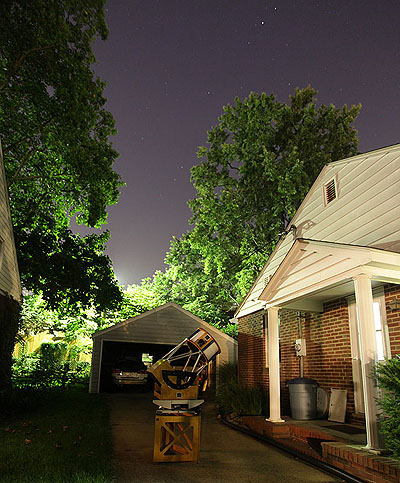 First
light took
place in
early September, and was conducted with the OTA only sitting on a
blanket in my driveway. The
focal plane was in about the right spot, and all eyepieces focused.
Initial testing showed that the prototype
Paracorr 2 was still
working very well at F/2.55. I also learned that I had gotten
fairly close on the collimation.
This was promising optically and mechanically.
First
light took
place in
early September, and was conducted with the OTA only sitting on a
blanket in my driveway. The
focal plane was in about the right spot, and all eyepieces focused.
Initial testing showed that the prototype
Paracorr 2 was still
working very well at F/2.55. I also learned that I had gotten
fairly close on the collimation.
This was promising optically and mechanically.I checked the size of the secondary mirror by putting my eye at the focal plane - I could just see all of it in the offset secondary mirror, so it was perfectly sized in my judgement. I also defocused a star and looked for the shadow of my finger as it was brought into the light path at the front of the secondary cage, and it appeared at the proper places, confirming that the mirror was catching all or very close to all of the light cone. Thus, I had no motivation to go up to a 5" flat, since it was not needed.
I told Al Nagler that things were looking good. We were eager to meet at Okie-Tex in a week or two and give things a serious shakedown.
With the OTA complete, I found the balance point and decided on the diameter of the bearings and height of the rocker box. The rocker has a 3/4" thick bottom board, 1/2"-thick side boards, and 1/4"-thick front and back boards, so it is quite light.
The fully completed telescope debuted on September 9, 2009 - I guess 9 is my lucky number, because it was 9/9/09. In my overlit driveway (see picture at right), I assembled the scope for the first time. It sat on my equatorial platform and the 24"-high triangular wooden stand that I made to go under the platform in order to elevate my 12.5" F/12.5 Cassegrain to a convenient height for use. As it turns out, the 14.5" F/2.55 OTA is shorter than the Cass OTA, and the stand/platform/scope combo is the perfect height for me. You can see the whole "stack" in the photos that follow below.
My testing quickly showed that the new Paracorr was correcting nearly all of the coma in a 13mm Ethos field, with almost no field curvature! This was fantastic. The 17mm showed some coma at the edges of the field, but was still very good. I had the spacing for the 8mm Ethos set wrong, so I instead turned to the 9mm, 5mm, and even 3.5mm Type 6 Naglers. Yes, the seeing was good enough to use the 3.5mm for a bit, but I mainly used the 5mm.
I spent some time tweaking the Paracorr 2 position to minimize spherical aberration. This paid off - Jupiter looked spectacular!
My friend John Stone stopped by and was similarly impressed. Jupiter was making its 1.5-hour appearance between the two large trees that lie to the south of my driveway, and the seeing, amazingly enough, was cooperating. We looked at many belts, lots of detail within the equatorial belts, and some subtle shadings near the poles.
It was unreal, doing planetary observing with a 14.5" telescope from my driveway, looking over my garage, pretty much the worst observing site it would be ever be used at.
As Jupiter slid behind the large tree just after midnight, I disassembled the scope and packed for Okie-Tex. We left the next evening, driving through Thursday night to get to the dark skies of Camp Billy Joe, near Kenton, OK.
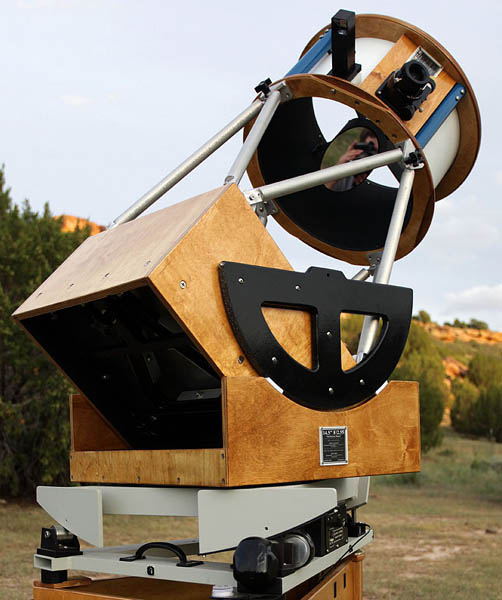 The 2009
Okie-Tex Star Party was a bit different than the two previous years I
had attended. As we passed Boise City, we notice that the
normally parched pastures were kind of green, and cattle actually had
something to feed on. The observing field was light green
when we
pulled in (see photo), and we hoped that this would mean less dust in
the air and on our optics.
The 2009
Okie-Tex Star Party was a bit different than the two previous years I
had attended. As we passed Boise City, we notice that the
normally parched pastures were kind of green, and cattle actually had
something to feed on. The observing field was light green
when we
pulled in (see photo), and we hoped that this would mean less dust in
the air and on our optics.
Friday night (we arrived early with the permission of the setup crew)
featured sucker holes. After hearing Al Nagler's voice across
the
field, we invited him over and we viewed through the sucker holes with
my 14.5" F/2.55 experimental scope until it was basically socked
in. Lightning flashed in the distance, but no thunder was
heard. I put the scope away where it would stay dry.
Saturday night was mostly hazy, and the main observing target was Jupiter through the haze. However, it was uncharacteristically steady, and Jupiter looked quite amazing for most of the evening, featuring some dark gray colored markings protruding from one of the equatorial belts. They were notable enough that I had to check online to see if something was afoot on Jupiter, but it wasn't.
Following this, on subsequent evenings before dark and during the night we decided to put the 14.5" f/2.55 through its paces, and Al Nagler was there to help. We looked at terrestrial objects as well as those in the sky.
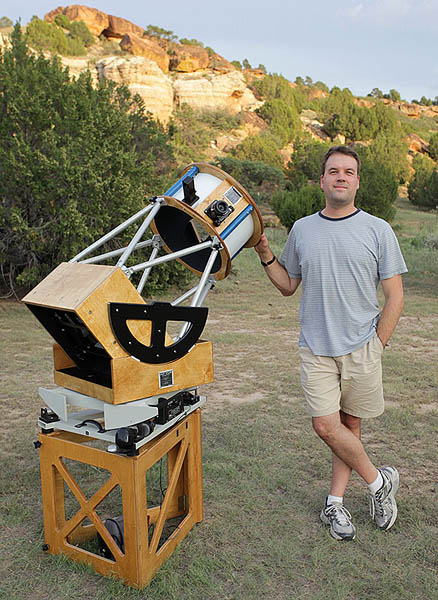 Our
first
night at Okie-Tex was spent slewing the scope around and
trying to view as quickly as possible so the other people that were
around could have a chance to see the object before the sucker hole
closed or moved on. Despite this, Al Nagler and Rick
Singmaster
were impressed.
Our
first
night at Okie-Tex was spent slewing the scope around and
trying to view as quickly as possible so the other people that were
around could have a chance to see the object before the sucker hole
closed or moved on. Despite this, Al Nagler and Rick
Singmaster
were impressed.Over the next six days, countless people viewed with the telescope and so far as I could tell, they were all quite impressed. On one evening a spirited (pun intended) group including James Mulherin and Jimi Lowrey enjoyed the telescope for at least half an hour.
As soon as the telescope was uncovered, event attendees appeared - smiling, looking puzzled, walking around it, asking questions, and just generally not believing what they were seeing. Most said they'd be back later to see if it really worked, and most did return and had their doubts erased.
Eyepiece Testing
The new 21mm Ethos is a fantastic eyepiece, especially at F/3.3 in the 22" Super FX Starmaster that Rick Singmaster brought along. You can read about this below or here. However, at F/2.55 the 21mm shows some coma in the outer parts of the field. Despite this, it is still an enjoyable view, with a field 1.9 degrees wide! Scanning the dark nebulae of the Milky Way with that eyepiece in my 14.5" scope was a religious experience for me, and one that must be repeated as soon as possible!
Correction improves with the 17mm Ethos, and is superb with the 13mm. All of the high power eyepieces we tested - 6mm, 8mm, and 10mm Ethos, as well as the T6 Naglers, worked very well.
As for the new Paracorr 2, intended for mirrors faster than F/4, it simply works.... very, very well. Al is going to have some trouble getting his prototype back! Hopefully it will be available to fast-mirror users very soon.
Collimation - not a problem
Collimation was done in two stages. First, I used my red-dot laser collimator to align the secondary and roughly align the primary. I collimate this laser periodically, and this is necessary to get good accuracy. Then I use an autocollimator to tweak the primary's alignment. If I was careful about aligning the secondary, this two-step procedure would nail the collimation. The only drift I experienced was due to not having the spider vanes tightened up sufficiently. That was quickly remedied.
So, with proper tools and care, I could nail the collimation of an F/2.55 telescope in less than five minutes. So, to anyone that says you can't collimate such an instrument, I am here to say that they are wrong.
On two evenings, Al Nager commendeered the telescope to test the Paracorr and eyepieces by focusing on portions of the ridges adjoining the camp (see photos below). We looked at bushes, a large cross, pink flamingos (an Okie-Tex tradition), and branches and blades of grass, all up on the ridges. Al was very happy with how his corrector was working.
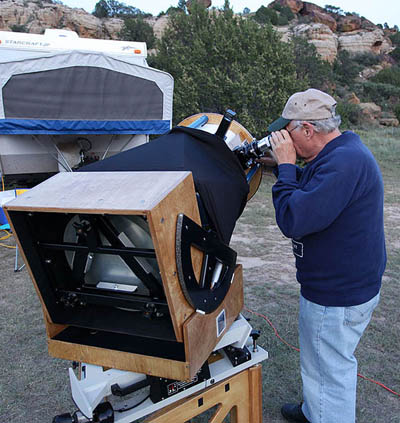
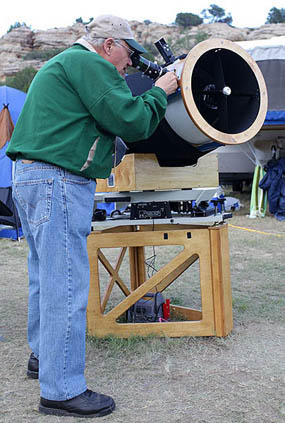
Al tests it some more.... and he gives his verdict of the system performance and makes my day.
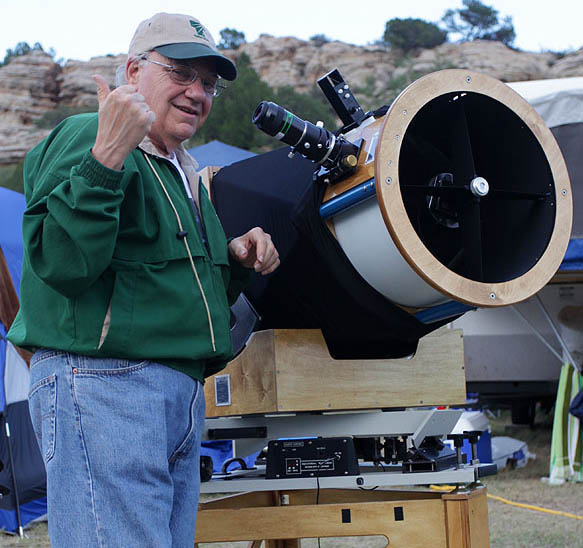
My thanks to Al Nagler for making the new Paracorr 2 and the Ethos eyepieces - these really made this telescope, telescopes like my 20" f/3, and commercial instruments at f/3.3, practical and allows them to reach the performance level of quality slower instruments.
Also, thanks to John Pratte for his excellent work on the mirror cell, spider, and truss pole bundle for my 14.5" f/2.55.
IN CONCLUSION - yes, the secondary mirror is large enough, yes the new Paracorr makes a big difference and I highly recommend it for sub-F/4 mirrors, and yes, an F/2.55 telescope can provide quality views of planets.
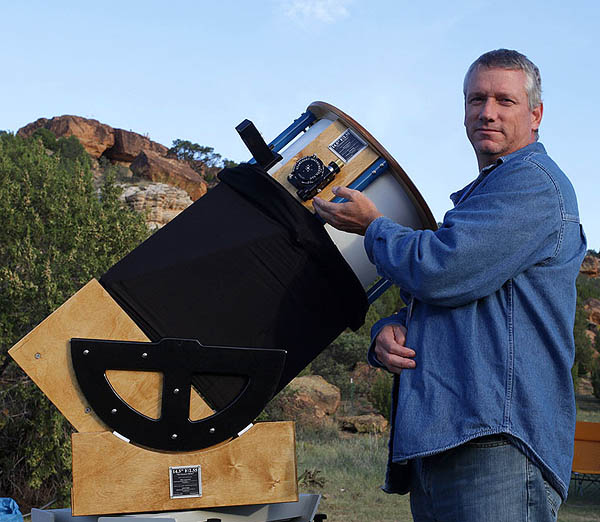
John Joseph, the new owner of Starlight Instruments, says, "Yeah, I made part of this."
Without that FeatherTouch I wouldn't be focusing nearly as easily. That fine-control knob truly does move with a feather's touch, and this is vital at F/2.55. John has since produced larger knobs for the fine-focus adjustment, making focusing quite easy for very fast telescopes.
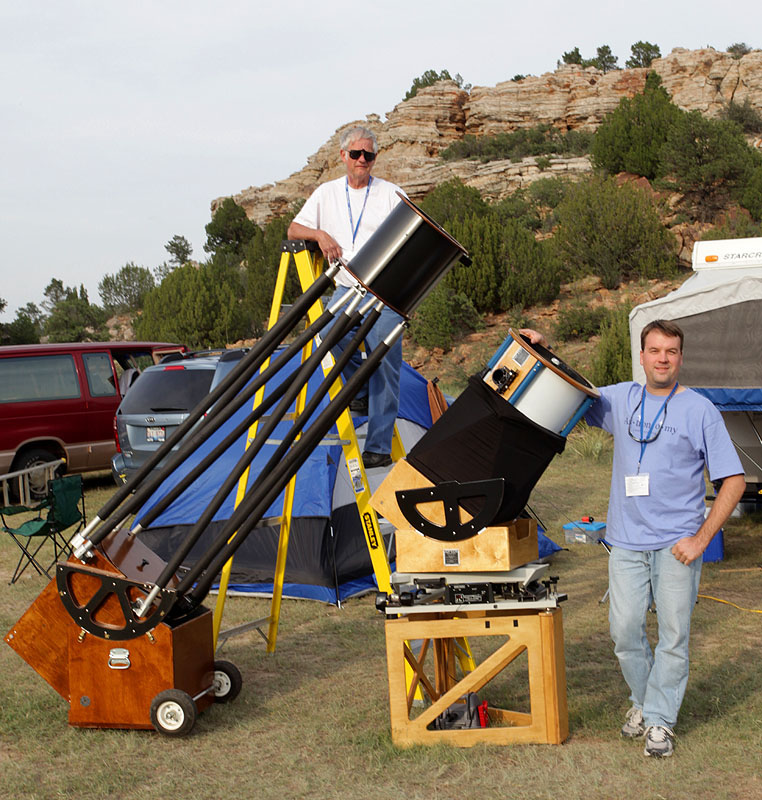
John Pratte, of JPAstrocraft.com on the ladder, shows of his fine 12.5" F/8.6 Newtonian while I keep my feet on the ground. We couldn't resist this photo-op.
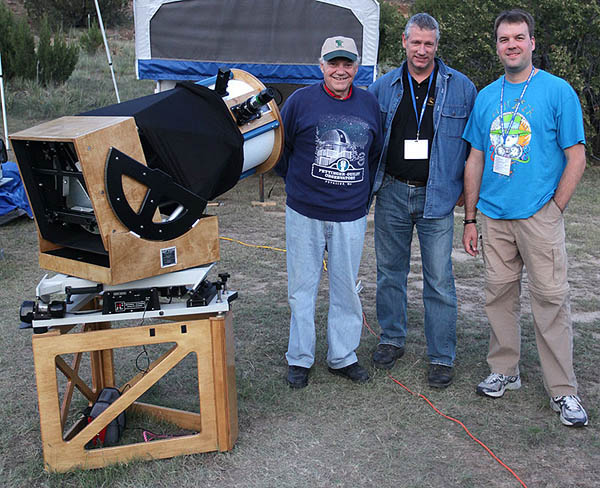
Finally, here's the group that made the telescope useable - Al Nagler at left, John Joseph in the middle, and I am on the right. Ironically I am wearing my Winter Star Party t-shirt, and that is probably where this telescope will make its next public appearance.
Suddenly a 30" F/2.8 telescope seems like a good idea......
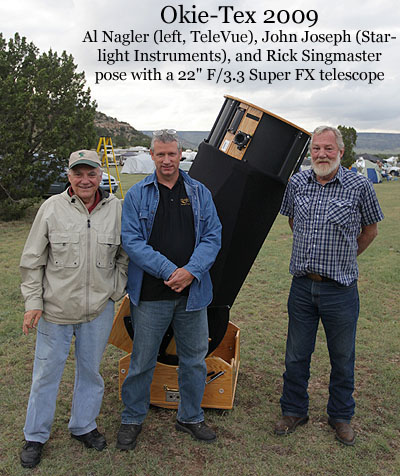
After a bit of testing/debugging at the star party (remember, Rick thoroughly tests every Starmaster telescope), we had spectacular view through the 22" F/3.3 Super FX pictured above. High powers were utilized, and images remained tack sharp in the better-than-normal seeing conditions. We viewed comfortably at the zenith with one step up on the StarStep Observing Chair. The size of the scope and quality of the views made it simply a joy to use, with goto and tracking to make finding object and observing at high power a breeze.
Here's what Rick had to say about the event:
Even Al Nagler was pleased with the view as he spent several hours at the scope with his "New" Paracorr and the latest addition to the eyepiece lineup, the 21mm Ethos. The Paracorr and Ethos combination, at ALL POWERS, gave excellent sharpness and contrast out to the edge of the field of view.
Glad I went. Saw many old friends and customers I hadn't seen in a number if years. This alone is a good enough reason to attend! Thanks to the Star Party organizers, the experience will be memorable. -Rick
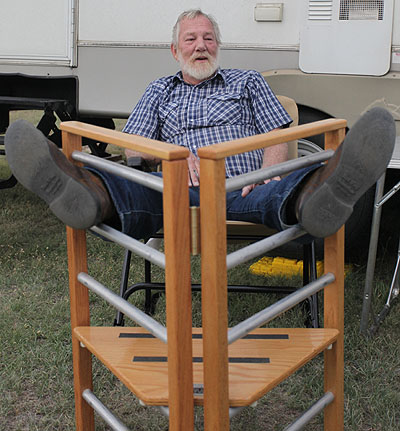 Here's
a
photo of Rick,
taking it easy at Okie-Tex 2009, and showing yet another great use for
the very functional StarStep Observing Chair - they make a dandy
footstool!
Here's
a
photo of Rick,
taking it easy at Okie-Tex 2009, and showing yet another great use for
the very functional StarStep Observing Chair - they make a dandy
footstool!Sunday
and
Monday night were probably our best observing, with clouds coming and
going. Tuesday night also featured intermittent clouds, and a
borrowed sky quality meter read as good as magnitude 21.8 this
year. Not quite as good as the 21.9+ that I saw in 2007, but
better than the 21.5 of last year. It's all a function of
dust,
pollution and particulates from forest fires that ends up in the air
over Camp
Billy Joe, but the lack of light pollution is the constant so
far. For this year, wind was really not an issue.
On
Wednesday
I gave back-to-back talks after lunch, and that was work.
Midway
through the second talk my brain was having a hard time functioning,
but I made it through, barely finishing on time. I still had
fun,
and I always enjoy giving talks.
In case
you're wondering, the protoype Paracorr 2 provided excellent images in
the 22" F/3.3. It is
highly recommended, as is the 21mm Ethos. Al's prototype
spent a
lot of time in the 22", and it is a winner, providing spectacular wide
field views.
So, if
you
see "Uncle" Al Nagler somewhere, thank him for helping to make the FX
and Super FX Series Starmasters possible with the Ethos and his
"souped-up" faster Paracorr, and for thus doing his part to help
shorten or get rid of observing ladders.
Clear, dark skies, warm weather, good friends, and good seeing.
-Mike Lockwood, Lockwood Custom Optics